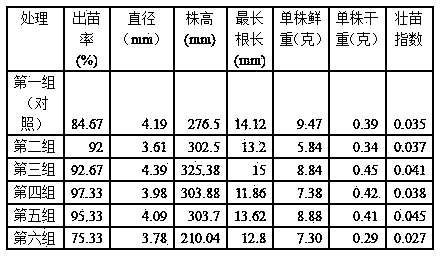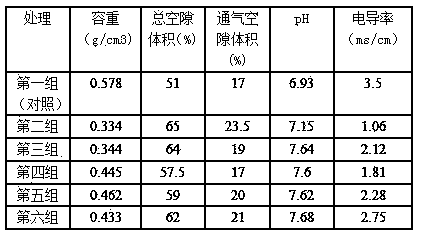Vegetable seedling raising matrix taking water hyacinth residues as main part and preparation method of vegetable seedling raising matrix
A technology of vegetable seedling substrate and water hyacinth, which is applied in plant seedling and agricultural fields, can solve the problems of low economic benefit and low added value of products, and achieve the effect of increasing utilization income and increasing added value
- Summary
- Abstract
- Description
- Claims
- Application Information
AI Technical Summary
Problems solved by technology
Method used
Image
Examples
Embodiment 1
[0019] After the fresh water hyacinth is crushed and extruded to form water hyacinth slag with a water content of 50% to 60%; if the water content of the water hyacinth slag obtained by direct processing is too high, it should be stacked into strips and stacked every 2 hours Turn it over with a turning machine until the water content is reduced to 50%~60%.
[0020] Then, stack and ferment the water hyacinth dregs with a water content of 50% to 60%. Here, you can also use a strip-stack stacking method, and turn it over with a turning machine every 2 days to ensure that the fermentation temperature during the decomposing process is The time above 50°C is more than 7 days, and the water hyacinth dregs with a maturity of 80% and a water content of 30% to 40% are formed by stacking, and they are set aside;
[0021] Mix well-decomposed water hyacinth dregs with a maturity of 80% with vermiculite, perlite, and peat, and stir evenly to form a vegetable seedling substrate.
[0022] Th...
Embodiment 2
[0024] Obtain six groups of vegetable cultivation substrates according to the following methods:
[0025] The first group: buy ordinary cultivation substrate directly in the market. (Product information: Cultivation substrate produced by Su Zhenjiang Xingnong Company)
[0026] According to the following 5 different mixing volume ratios, the cultivation substrate was obtained by using the preparation method in Example 1.
[0027] The second group: water hyacinth dregs: vermiculite: perlite: peat=3:1:3:3.
[0028] The third group: water hyacinth dregs: vermiculite: perlite: peat=4:1:2:3.
[0029] The fourth group: water hyacinth dregs: vermiculite: perlite: peat=5:1:1:3.
[0030] The fifth group: water hyacinth dregs: vermiculite: perlite: peat=6:1:1:2.
[0031] The sixth group: water hyacinth dregs: vermiculite: perlite: peat=7:1:1:1.
[0032] The above six groups of seedling substrates were investigated for their physical and chemical properties, and the results are shown...
Embodiment 3
[0036] According to the method in Example 2, six groups of vegetable seedling substrates were obtained, and they were respectively applied in the cultivation of solanaceous fruits, melons and leafy vegetables, and multiple sets of experimental data were obtained, statistical results were obtained, and their effects on plants were investigated. The impact of growth conditions, the results are shown in Table 2:
[0037] Table 2
[0038]
[0039] Among them, under the condition of the mixing ratio of the fifth group, the seedling emergence rate and the total yield are better than other mixing ratios, which is the preferred mixing ratio.
PUM
 Login to View More
Login to View More Abstract
Description
Claims
Application Information
 Login to View More
Login to View More - R&D
- Intellectual Property
- Life Sciences
- Materials
- Tech Scout
- Unparalleled Data Quality
- Higher Quality Content
- 60% Fewer Hallucinations
Browse by: Latest US Patents, China's latest patents, Technical Efficacy Thesaurus, Application Domain, Technology Topic, Popular Technical Reports.
© 2025 PatSnap. All rights reserved.Legal|Privacy policy|Modern Slavery Act Transparency Statement|Sitemap|About US| Contact US: help@patsnap.com


